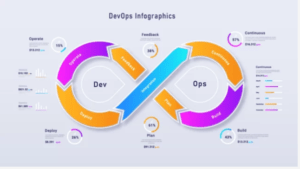Table of Contents
ToggleIntroduction.
In the fast-evolving digital landscape, where agility, speed, and innovation determine business success, organizations are racing to modernize their IT infrastructure and embrace the power of the cloud. Cloud computing has become more than just a trend it’s now the foundation of digital transformation. From startups to global enterprises, companies are migrating their workloads, applications, and data to cloud environments such as Amazon Web Services (AWS), Microsoft Azure, and Google Cloud Platform (GCP). This migration promises scalability, flexibility, and cost-efficiency that traditional on-premises systems could never fully deliver. However, while moving to the cloud unlocks new opportunities, it also introduces complex challenges around deployment, security, and collaboration.
That’s where DevOps enters the picture not as a tool or technology, but as a cultural and operational revolution. DevOps bridges the gap between development (Dev) and operations (Ops), breaking down the silos that have traditionally separated teams. It brings together people, processes, and tools to enable seamless collaboration, continuous integration, automated deployment, and faster delivery of software. When DevOps principles are combined with the elasticity and automation capabilities of cloud computing, the result is nothing short of transformative. Together, they create an ecosystem where innovation flows freely, systems adapt dynamically, and organizations can scale both technologically and strategically.
The journey toward cloud transformation isn’t merely about shifting servers from data centers to cloud providers. It’s about redefining how businesses build, deploy, and maintain software. Traditional IT models rely heavily on manual configurations, lengthy deployment cycles, and reactive operations. These approaches struggle to keep pace with the demands of modern digital experiences where users expect instant updates, zero downtime, and constant innovation. DevOps, on the other hand, empowers teams to automate infrastructure management, integrate testing early in the development process, and release updates continuously. When paired with cloud platforms, this leads to faster feedback loops, improved reliability, and efficient use of resources.
Another key advantage of blending DevOps with cloud transformation is scalability. In the cloud, infrastructure can expand or shrink on demand, ensuring optimal performance without wasting resources. DevOps methodologies take full advantage of this elasticity through Infrastructure as Code (IaC), enabling teams to define and manage environments programmatically. With tools like Terraform, CloudFormation, and Ansible, organizations can spin up entire systems within minutes consistent, repeatable, and secure. This automation reduces human error and accelerates the deployment process, allowing engineers to focus on innovation instead of maintenance.
Beyond automation, DevOps introduces a cultural mindset shift that’s vital for successful cloud adoption. It promotes shared ownership, collaboration, and accountability across departments. Developers, testers, security experts, and operations engineers work together throughout the entire application lifecycle. This synergy ensures that software is not only developed faster but also maintained more effectively. The cloud amplifies this collaboration by providing centralized, scalable environments accessible from anywhere breaking down geographic and organizational barriers.
Monitoring and continuous improvement are also at the heart of DevOps-driven cloud transformation. Modern applications are complex and distributed across multiple services, regions, and platforms. DevOps leverages real-time monitoring tools like Prometheus, CloudWatch, and Datadog to track system performance, detect anomalies, and provide actionable insights. These feedback loops enable teams to respond proactively, prevent downtime, and deliver consistent user experiences. In the cloud, this observability becomes even more powerful, offering full visibility into resource usage, cost patterns, and application health.
DevOps is the engine that powers cloud transformation. It turns cloud migration from a one-time technical project into an ongoing process of evolution and optimization. By integrating automation, collaboration, and continuous delivery, DevOps ensures that businesses can innovate rapidly, respond to market changes effectively, and achieve operational excellence. Whether you’re a small team just starting your cloud journey or a large enterprise modernizing legacy systems, understanding how DevOps drives cloud transformation is the key to unlocking your organization’s full potential.
This guide will explore how DevOps accelerates cloud adoption, streamlines workflows, enhances security, and fosters a culture of innovation. For beginners, it will serve as a roadmap showing not just the what and why of DevOps and cloud transformation, but also the how. By the end, you’ll understand how these two forces work hand-in-hand to shape the future of technology, empower teams, and redefine what’s possible in the digital era.
What Is Cloud Transformation?
Cloud transformation is far more than simply migrating applications or data from local servers to cloud platforms it represents a complete rethinking of how an organization operates, innovates, and delivers value in the digital age. At its core, cloud transformation is the strategic process of modernizing IT infrastructure, software systems, and business operations by leveraging the scalability, flexibility, and efficiency of cloud computing. It involves moving away from traditional, hardware-dependent environments and embracing cloud-native technologies that enable agility, automation, and innovation at scale. This shift empowers organizations to adapt quickly to changing market conditions, accelerate product delivery, and improve collaboration across teams.
In traditional on-premises setups, businesses rely on physical data centers, manual provisioning, and rigid infrastructure that often limits scalability and responsiveness. However, in a cloud-based model, resources such as computing power, storage, and networking are delivered on-demand via internet-based platforms like Amazon Web Services (AWS), Microsoft Azure, or Google Cloud Platform (GCP). This means that instead of purchasing and maintaining costly hardware, companies can pay only for what they use and scale resources dynamically as demand fluctuates. The ability to scale up or down instantly allows organizations to stay cost-efficient while maintaining performance and availability something that was difficult to achieve in the traditional IT world.
Yet, cloud transformation isn’t just about cost savings or flexibility it’s about unlocking innovation and agility. By adopting cloud-native architectures such as containers, microservices, and serverless computing, businesses can develop and deploy software faster than ever before. These architectures enable developers to build modular, lightweight applications that can be updated independently without disrupting the entire system. This approach leads to faster iteration cycles, continuous integration, and continuous delivery (CI/CD), all of which are essential for staying competitive in a rapidly evolving digital market.
Another vital aspect of cloud transformation is automation. Manual infrastructure management is error-prone, time-consuming, and difficult to scale. Through Infrastructure as Code (IaC) tools like Terraform, CloudFormation, and Ansible, organizations can define their cloud environments programmatically. This ensures consistency, repeatability, and efficiency in deploying resources. Automation extends beyond infrastructure it influences testing, security, monitoring, and deployment, creating a seamless ecosystem where systems self-adjust based on workload demands and performance metrics.
Cloud transformation also brings significant improvements to collaboration and remote work. Because cloud environments are accessible from anywhere, teams can develop, test, and deploy applications in real-time, regardless of their physical location. Integrated collaboration tools and cloud-based workflows foster communication between developers, IT operations, business analysts, and even external partners. This accessibility and transparency are particularly crucial in the modern era, where distributed teams and global operations have become the norm.
Security and compliance are critical considerations during cloud transformation. Contrary to the myth that the cloud is less secure, leading cloud providers offer advanced security frameworks, encryption, and compliance certifications that exceed traditional standards. However, organizations must adopt a shared responsibility model, where the cloud provider secures the infrastructure while the business ensures that applications, access controls, and data policies are properly managed. Implementing DevSecOps practices integrating security into every stage of development and deployment further strengthens the organization’s security posture in the cloud.
Moreover, cloud transformation isn’t only about technology; it’s about people and processes. Successful transformation requires a shift in mindset and culture. Teams must move from rigid hierarchies to agile, collaborative models. Business leaders must foster a culture of experimentation, continuous learning, and cross-functional communication. Cloud adoption enables IT departments to become strategic partners rather than just support functions driving innovation, optimizing costs, and improving customer experiences.
A well-planned cloud transformation journey typically involves several stages: assessment, migration, modernization, and optimization. In the assessment phase, organizations evaluate their existing infrastructure, identify workloads suitable for migration, and determine the best cloud strategy whether public, private, or hybrid. During migration, workloads and applications are moved to the cloud using various approaches such as lift-and-shift, re-platforming, or re-architecting. Modernization follows, where applications are redesigned using cloud-native technologies for better performance and scalability. Finally, optimization ensures ongoing improvements in cost management, performance tuning, and security compliance.
Cloud transformation is not a one-time project but an ongoing journey. Technology continues to evolve, and so must the strategies and systems that support it. Organizations that embrace the cloud effectively gain the ability to innovate continuously, respond faster to market demands, and enhance customer satisfaction. They become more resilient, data-driven, and prepared for the future. Whether a company is a small startup seeking flexibility or a large enterprise pursuing digital reinvention, cloud transformation serves as the foundation for sustainable growth and competitive advantage in the modern world.
What Is DevOps?
DevOps is much more than a set of tools or a technical methodology; it is a cultural, operational, and technological approach that bridges the traditional gap between software development (Dev) and IT operations (Ops). Historically, development and operations teams worked in silos, with developers focusing on writing code and building applications, while operations teams concentrated on deploying and maintaining infrastructure. This separation often led to slow release cycles, miscommunication, deployment errors, and a lack of accountability. DevOps emerged as a solution to these challenges, aiming to unify people, processes, and technology into a continuous, collaborative workflow that delivers software faster, more reliably, and with higher quality.
At its core, DevOps is about automation, collaboration, and continuous improvement. Automation plays a critical role in streamlining repetitive tasks such as building, testing, deploying, and monitoring applications. By automating these processes, organizations can reduce human error, save time, and ensure consistent results across development, testing, and production environments. Tools like Jenkins, GitHub Actions, GitLab CI/CD, and CircleCI are widely used to implement these automated pipelines, enabling continuous integration (CI) and continuous delivery/deployment (CD). CI/CD ensures that code changes are automatically tested and deployed, minimizing downtime and accelerating the feedback loop between development and operations teams.
Another central pillar of DevOps is collaboration. DevOps promotes a cultural shift where development, operations, quality assurance, security, and even business teams work together throughout the entire software lifecycle. This collaboration reduces silos, encourages shared ownership, and aligns teams with business objectives, rather than allowing them to operate in isolation. Practices such as daily stand-ups, shared dashboards, cross-functional teams, and integrated workflows foster transparency, communication, and faster problem-solving. When teams collaborate effectively, they can identify bottlenecks early, respond to customer needs rapidly, and ensure that applications are reliable and scalable.
Infrastructure as Code (IaC) is another essential component of DevOps. IaC allows teams to define and manage infrastructure programmatically, rather than relying on manual configuration. Tools like Terraform, Ansible, and AWS CloudFormation enable engineers to provision, configure, and maintain servers, databases, and networks consistently across environments. This not only improves efficiency but also ensures repeatable and auditable processes, which are crucial for security and compliance. In a cloud environment, IaC allows organizations to dynamically scale resources, adapt to changing workloads, and maintain resilience, making DevOps and cloud computing a natural fit.
Monitoring, logging, and observability are also fundamental to DevOps. In modern applications that are distributed across multiple servers, microservices, and regions, real-time monitoring tools like Prometheus, Grafana, Datadog, and AWS CloudWatch provide insights into system performance, errors, and bottlenecks. By implementing continuous monitoring, DevOps teams can proactively detect issues, troubleshoot effectively, and optimize application performance. This focus on feedback loops allows for continuous learning and improvement, which is a hallmark of the DevOps philosophy.
Security is another critical consideration, and modern DevOps practices often integrate security into the pipeline an approach known as DevSecOps. Instead of treating security as a separate, late-stage process, DevSecOps embeds security checks, compliance audits, and vulnerability scans into every phase of development and deployment. This ensures that applications are secure by design, rather than relying on reactive fixes after vulnerabilities are discovered. By combining security, development, and operations, organizations can maintain high levels of reliability and trust while delivering features rapidly.
DevOps is a strategic enabler for organizations seeking agility, innovation, and operational excellence. By uniting development and operations, fostering automation, implementing continuous integration and delivery, and promoting collaboration, DevOps transforms the software lifecycle into a seamless, efficient, and resilient process. It allows organizations to release software faster, respond to market changes proactively, improve customer satisfaction, and optimize resources.
In the modern IT landscape, DevOps has become essential not only for software teams but for the overall success of digital transformation initiatives, particularly when combined with cloud computing. Together, DevOps and the cloud create an ecosystem where scalability, efficiency, and innovation thrive enabling businesses to compete effectively, respond quickly to customer demands, and continually evolve in a fast-paced digital world. DevOps is, in essence, the engine that powers modern software development and delivery, making it a cornerstone of any organization’s journey toward digital maturity.
The Connection Between DevOps and Cloud Transformation.
The relationship between DevOps and cloud transformation is both strategic and symbiotic, creating a powerful combination that drives faster innovation, operational efficiency, and business agility. Cloud transformation provides organizations with scalable, flexible, and cost-effective infrastructure, but without a robust operational framework, the full potential of the cloud cannot be realized. DevOps fills this gap by streamlining processes, automating workflows, and fostering collaboration between development and operations teams. Together, DevOps and the cloud enable organizations to modernize their IT systems, deliver software continuously, and respond quickly to market demands while minimizing errors and downtime.
Cloud platforms such as AWS, Azure, and Google Cloud offer on-demand computing resources, storage, and networking capabilities, allowing businesses to scale dynamically based on workload requirements. DevOps complements this by implementing automation and continuous integration/continuous deployment (CI/CD) pipelines, which allow code to be tested, deployed, and monitored consistently across cloud environments. By using tools like Terraform, Ansible, Jenkins, GitHub Actions, and Kubernetes, DevOps teams can provision cloud infrastructure as code, orchestrate containers, and deploy applications reliably, all while reducing manual intervention and human error.
One of the most significant ways DevOps drives cloud transformation is through automation. Cloud computing allows rapid provisioning and scaling, but managing this manually would be complex and error-prone. DevOps leverages automation to create repeatable and consistent workflows, from infrastructure setup to application deployment and monitoring. This ensures that development, testing, and production environments are synchronized, reducing configuration drift and enabling faster delivery cycles. Automation also empowers teams to experiment safely, deploy updates rapidly, and recover quickly from failures, which is critical in dynamic cloud environments.
Continuous integration and continuous deployment (CI/CD) pipelines are another key link between DevOps and the cloud. These pipelines automate the building, testing, and deployment of code, allowing organizations to release features quickly without compromising quality. In a cloud context, CI/CD pipelines can leverage elastic infrastructure to run tests in parallel, provision temporary environments, and deploy updates globally in minutes. This combination of DevOps processes and cloud scalability enables organizations to achieve agility and responsiveness that would be impossible in traditional on-premises setups.
Monitoring, observability, and feedback loops are also strengthened by the integration of DevOps and cloud transformation. Modern applications often run across distributed microservices and multiple regions, making visibility into system performance critical. Cloud-native monitoring tools such as CloudWatch, Datadog, Prometheus, and Grafana allow DevOps teams to track metrics, detect anomalies, and respond proactively to issues. By incorporating monitoring and feedback into the DevOps workflow, organizations can continuously optimize both applications and cloud infrastructure, ensuring reliability, efficiency, and customer satisfaction.
Scalability and flexibility are hallmarks of the DevOps-cloud connection. DevOps practices like Infrastructure as Code (IaC) enable teams to define, replicate, and manage cloud environments programmatically. This makes it easy to scale applications up or down based on demand, deploy new features in isolated environments, and maintain consistency across multiple regions or accounts. The cloud provides the resources, while DevOps provides the automation, governance, and control to use those resources effectively, creating a highly adaptive and responsive technology ecosystem.
Security is another dimension where DevOps and cloud transformation converge. Cloud providers offer built-in security features, encryption, and compliance tools, but DevOps ensures these measures are integrated throughout the development and deployment lifecycle. Practices such as DevSecOps embed security testing and vulnerability management into CI/CD pipelines, ensuring that applications are secure by design. This alignment allows organizations to innovate rapidly in the cloud while maintaining regulatory compliance, protecting sensitive data, and minimizing risks.
Finally, the connection between DevOps and cloud transformation is also cultural and organizational. DevOps promotes cross-functional collaboration, shared responsibility, and transparency, while cloud computing enables teams to access centralized, scalable environments from anywhere. Together, they break down silos, encourage experimentation, and accelerate digital transformation initiatives. Organizations that successfully integrate DevOps and cloud strategies experience faster time-to-market, improved reliability, cost optimization, and enhanced innovation, making them more competitive and resilient in today’s fast-paced digital landscape.
DevOps and cloud transformation are inseparable partners. Cloud platforms provide the infrastructure and capabilities to modernize IT operations, while DevOps supplies the processes, automation, and cultural shift necessary to fully leverage the cloud. By combining the two, organizations unlock the true potential of digital transformation, achieving speed, efficiency, scalability, and innovation that set them apart in an increasingly competitive world.
Benefits of Integrating DevOps into Cloud Transformation.
Greater Innovation:
When infrastructure and deployment are automated, teams can focus on experimentation and business value.
Faster Time-to-Market:
Continuous delivery pipelines mean new features and fixes reach customers quickly.
Improved Reliability:
Automated testing and monitoring ensure stable, predictable deployments.
Cost Optimization:
DevOps automation helps manage cloud resources efficiently, avoiding overuse and reducing waste.
Enhanced Security:
Integrating security checks early in the pipeline (DevSecOps) ensures compliance and protection at every stage.
Getting Started: Steps for Beginners
If you’re new to DevOps or cloud transformation, start small and scale gradually.
- Assess Your Current Infrastructure. Identify what can be migrated or automated.
- Adopt Version Control and CI/CD. Use Git and automation tools for consistent deployments.
- Implement Infrastructure as Code. Manage cloud resources programmatically.
- Build a DevOps Culture. Encourage collaboration, transparency, and continuous improvement.
- Monitor Everything. Track performance, costs, and security metrics in real time.
Final Thoughts
DevOps isn’t just a technical framework it’s a strategic enabler of cloud transformation. By aligning people, processes, and technology, DevOps empowers organizations to unlock the full potential of the cloud.
For beginners, the key is to start simple, automate gradually, and focus on collaboration. As your team matures, you’ll not only transform your infrastructure but also your entire approach to innovation.





